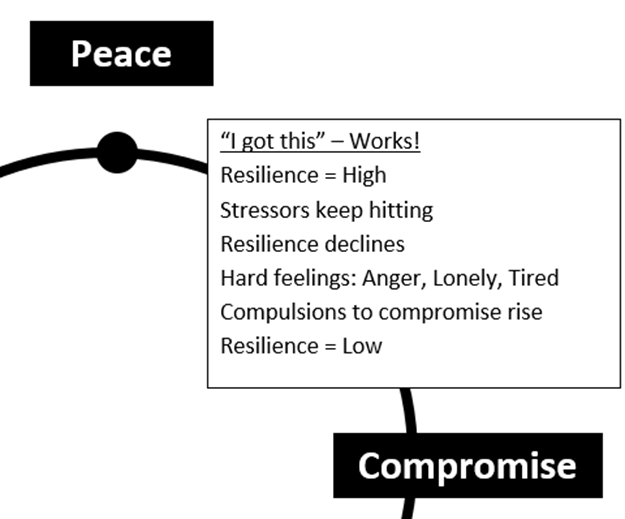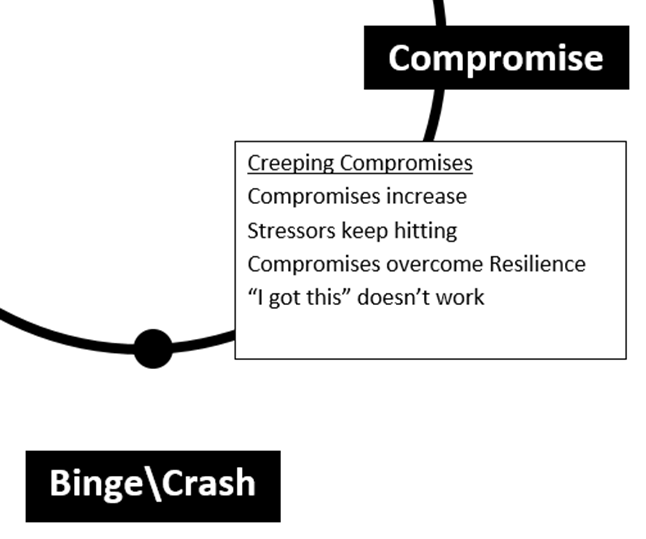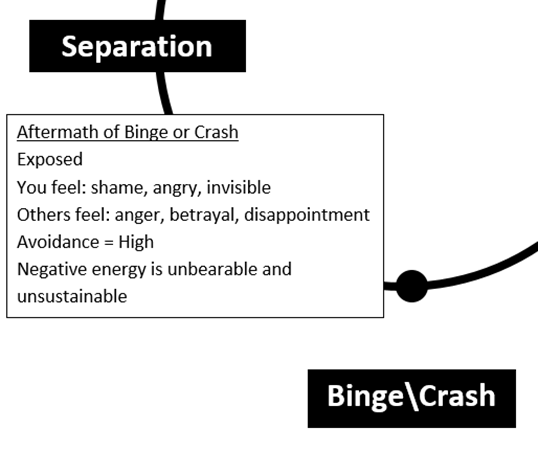Navigating the Hidden Mental Health Cycle that Every Man Faces: Why Going It Alone Fails
You’re strong. You’ve handled things on your own. But lately, the cracks are showing. This blog explores why emotional suppression may be sabotaging your resilience and what you can do instead.
A Fresh Perspective on Emotional Suppression in Men’s Mental Health
Men’s mental health is a serious concern yet men are less likely than women to receive mental health treatment. Many men compound their problems by emotional suppression and preferring “go it alone” instead of seeking help to solve problems. But when it comes to struggling with life’s problems and stressors, these strategies often get men stuck in a negative spin cycle. Maybe you are one of them. In these cycles, life stressors get too big to handle and big emotions rise. Your personal resilience fails which can lead to small compromises and ultimately to addictive binges of porn or alcohol or crashing in compulsions of anger or rage. The embarrassment and shame are too much to bear and asking for help is scary. To stop these spin cycles, what you need is awareness of how these cycles work, motivation to share big emotions and acceptance of the need to connect with people who can help. This can help you to stop the spin cycle and regain sanity.
The Cycle of Binge and Crash: Charting the Effect of Emotional Suppression
The cycle of binge and crash is conceptualized in 4 quadrants of Peace, Compromise, Binge\Crash and Separation.
Quadrant 1 begins with a sense of peace. There is no need to know or express feelings because of your belief and feeling that “I got this.” You believe you can beat the addictions or compulsions.
That seems to work. Then life’s stressors come hard as they always do. These include emotional ups and downs, relational disappointments, conflicts at work, financial binds, etc. But you believe your resilience is strong. You feel invulnerable so you believe there is no need to share emotions or fears. You don’t need help because you believe you are strong and can solve your own problems. At this point there seems to be no cost to emotional suppression.
But the stressors take their toll. If you had a resilience meter, you would see your resilience starts at full strength. But each stressor takes its toll and you begin to feel the emotions of anger, loneliness, shame and exhaustion. Then resilience declines, your brain gets foggy and you start to feel creeping compulsions for compromising behaviors: one small drink, one seemingly harmless look, silent anger.
In quadrant 2, resilience is worn down and compromises occur, small at first, then more frequent.
Still, you believe this time will be different—until resilience reaches near zero resulting in a crash or a binge or a binge of crashes.
Quadrant 3 is the aftermath of the binge or crash. It starts with your feelings of shame, hiding and anger. Your wife or other important people feel anger, betrayed and disappointment. Judgment is in the air. Eye contact is gone and avoidance is high. But the negative energy of this quadrant cannot be sustained, which results in separation.
Because life has to go on, an uneasy truce or separation becomes the norm. Quadrant 4 is characterized by silent, unspoken pleas and vows: I need you to stay clean, I promise you this is the last time. The angry air clears up but there is a haze of mistrust. It is more like an uneasy peace or truce than a reconciliation. You might be able to stay clean, but it is fear-driven. It might seem like this ends up as Peace, but it is a False Peace.
Awareness of the Cycle: Suppressing Emotions Which Are Signals to Change
Here is a birds-eye view of all four quadrants of this cycle.
Here are two questions… Does this feel right? Although your cycle may not play out exactly like this, aspects are clearly recognizable to those who are stuck in boom or bust addiction cycles. There is a false sense of invulnerability. There are rationalized and creeping cheats and compromises. There is the inevitable and devastating binge or crash. There is the painful aftermath, for everyone, with devastating feelings of shame and blame and disappointment. Then there is the uneasy truce, the unspoken vows, the reaffirmations and “never again” promises. This leads to a False Peace and the cycle continues.
How can this be stopped? Think about this question: In which quadrant do you have the greatest agency and resilience? Clearly, quadrant 1. In this quadrant you could choose healthy ways to engage stressors of life, work, children and relationships. Or you could deny and ignore and make bad choices which compound the stress. For instance, you could ignore the warning signs such as feelings of anxiety, depression, loneliness, boredom, etc. You could persist in suppressing those feelings and indulging the false belief that you can do this alone. You could neglect the ones you love the most by shutting down and shunning vulnerability. All these neglectful choices only increase stress and decrease your resilience. Inevitably your agency fades and compromises creep in.
You need to know why this repeatedly happens, again and again and again. Hard emotions are a feature of your emotional world. They can provide a blaring signal and urgency to make change. But some men are disconnected from their emotions (for reasons that would take another blog article to explain). They have suppressed these signals by avoiding them, symbolically covering them up with black electrical tape. Many men believe that emotions are too hard, too confusing, too embarrassing and they get in the way. But emotions and feelings don’t care, they are just trying to tell you that something is broken.
Left unchecked, those suppressed emotions don’t disappear; they detonate. Over time, the result of repeated suppressed emotions includes a loss of resilience, a craving to cope, and addictive behaviors that are rising in power. Tick tock, tick tock… Compromise creeps in… Clock keeps ticking… Crash!
The possible long-term consequences of suppressing emotions with repeated binges and crashes include the destruction of relationships, loss of marriage, being blocked from being a father or mother, and loss of self-respect. And it may also include loss of job or career.
Breaking the Cycle: Connecting Through Expressing Emotions, Mindfulness and Self-Awareness
With new and bold thinking, you can reverse this compromise creep. You can make life-saving changes in quadrant 1. The opposite of doing this alone is… Connection. The decision to connect is both a cognitive and emotional choice. This starts with Self-Awareness and a form of Mindfulness that rips off the black electrical tape and tunes you into your body’s warning system.
Mindfulness does not have to be lotus position meditating on a yoga mat. In its simplest form, mindfulness allows your mind to be aware of your feelings and thoughts. A good place to start is by using a simple feelings list to develop an emotional vocabulary and someone to talk to about them. The idea that focusing on hard feelings will reduce their power might seem counterintuitive. But decades of research including MRI scans of the brain shows that the awareness of feelings in your body and connecting those feelings to named emotions actually tames them and lessens their power over you. As an added benefit, this practice can also help you to become attuned to the emotional signals of your body. A therapist or a really good friend can help you with this step.
Sharing emotions is highly vulnerable but the payoff is great. It creates and strengthens connections with people who care about you. It promotes healthy relationship building. It eases anxiety or depression or other emotions.
Becoming accustomed to vulnerability will help you to take the next important step. Warning: taking this step will challenge a deeply felt societal norm that says, “I can do this by myself.” You now have the mind space and opportunity to make connections for problem solving. You don’t have to solve your problems alone; others can help you. The results will always be superior! Your community and family can help you with this step.
Summary
Addictions and behavioral crashes do not operate in a vacuum. They wax and wane according to rather predictable cycles. Do not expect the cycle described in this article to be exactly how your addictive cycle works. Instead use it as a starting point to become aware of how your cycle works. Become aware of how your resilience erodes. Learn the signals of your body and the associated feelings. Take the risk of sharing these feelings with others. Learn how to ask others for help.
Likewise, your patterns and your coping strategies do not emerge from nothing. Your personal and family history may have influenced you to cope with circumstances in repeated ways that eventually became an addiction. For additional help in understanding the roots of your addictive cycle, you should study the story of your Family of Origin. A helpful article for you to review is here: https://www.michaelhamerly.com/blog/family-of-origin-therapy/
For therapeutic and experiential help with all of these issues and topics, contact Mike Hamerly at The Warming Hut. Or you can read more about Men’s Therapy or Addiction Recovery Therapy. Your healing journey can begin today and recovery can become your achievable goal!







